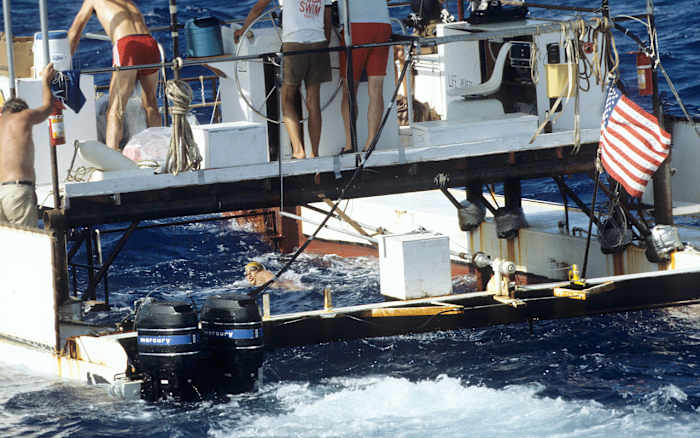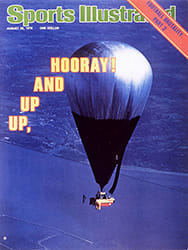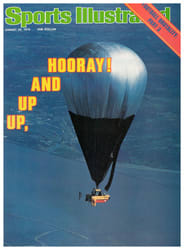An Ill Wind That Blew No Good
The dream was dying hard for Diana Nyad last week. Her Cuba-Key West swim was all but over, and now, with the dawning of the third, impossible day, and with her mind a blur from too little sleep and too much pain, she saw her friends' tears and heard their words, but she understood neither. "Everything went wrong," head trainer Margie Carroll sobbed to her. "You swam for 42 hours, but the wind pushed us too far west, and I'm so sorry, Diana, but I'm telling you now that you're not going to make it."
"But couldn't I keep going?" Nyad pleaded, shivering despite the 85° temperature of the Gulf Stream. Her words were barely intelligible; her tongue and lips were swollen from the salt water. "If I swam for 40 more hours, couldn't I make it then?"
"It can't be done, Diana," said Rich du Moulin, her co-navigator. "The wind is too strong against you, the waves are too high, and three of the four engines on the shark cage are dead. No swimmer could make it now, not even you." He spoke softly, as if to a child.
"But I can't quit. Isn't there some other place to swim for, some island maybe?"
"There is no other place, Diana. Key West is still the closest point, and it's 60 miles away."
She bobbed weakly in the 20' x 40' shark cage, a look of resignation growing in her puffy features, and finally she was saying over and over, "I wanted to make it so much.... I tried so hard.... I've never done anything so hard in my whole life." Her friends reached down to embrace her, and one said, "We're so proud of you, Diana." They lifted her gently from the water, her hands dangling down, bleached bone white and deeply furrowed. Applause broke out, and someone remarked, "She's the only thing in this project that worked." The phrase hung in the air.
"My own private Olympics," Nyad had called the swim, and she trained for a year, as if she were a one-woman Olympic team. Her plan was to start from Cuba in mid-July, when the winds usually are light and the waves in the Florida Straits smaller. But there were some procedural problems with the Cuban government and the swim was delayed. So it wasn't until Sunday, August 13, that she stood on Ortegosa Beach, about 50 land miles west of Havana, 130 sea miles southwest of Key West, her destination. Her trainers and support crew scurried about, yet Nyad looked incredibly alone. She stared at the choppy shallows and at the windblown mangroves, and she seemed to hesitate. But finally, vacantly, she said, "I guess I'll see you all in about 2½ days." Then she waded in to her waist and began a quarter-mile swim to the self-propelled shark cage, named "Cleopatra," which had cost a queenly $42,000 to build and which was now waiting offshore. It was 2:07 p.m.
She would swim north to the Gulf Stream, cut diagonally across it as it swept her eastward, and emerge from it on its other side, just offshore from Key West. It seemed that simple. But a northeast wind was blowing to 15 knots and more. It gusted across the open front of the cage, sending three-foot waves smacking into Nyad's face. They caromed off the inside of the pontoons on the cage, knocking her from side to side. Her navigators altered course slightly to the west, placing the cage more nearly parallel to the waves, waiting impatiently for the wind to die. But the bulky shark cage, which was powered by four 75-hp. outboards, was now moving at less than two knots, and it caught the wind like a sail. Although she could not know it, Nyad was heading more and more to the west, causing one frustrated crew member to wonder about a Cuba-Mexico swim.
The wind, which was supposed to die at dusk, blew into the night, and Nyad screamed as poisonous jellyfish washed against her arms. Her trainers bathed the stings with ammonia, but she was losing strength—from pain, from vomiting up her hourly feedings, from battling the waves. She shivered when she momentarily stopped swimming. She began to swim breaststroke and backstroke, slowing to only a mile an hour. "My God," she called out, "if it's this bad after only 12 hours..." At 2 a.m. her trainers fed her chicken soup, but she threw it up. The waves rose to four feet and Nyad said, "This is the worst night of my life."
At 4 a.m. her trainers played Simon and Garfunkel on a tape deck, the music blaring into the night, and Nyad said to an astonished trainer, " 'Joe DiMaggio, a nation turns its lonely eyes to you.' That means there are no more heroes, right?"
"Make this swim and you're it," Margie Carroll told her.
As day broke, she asked for chicken and Perrier water with dextrose, and she held it down. Now, energized by the rising of the sun and of her blood sugar, she swam strongly into Monday.
The press was waiting to spread the word. In addition to the shark cage, seven boats had been with Nyad from the start: two from Cuba and five others, carrying trainers, crew, and approximately two dozen U.S. journalists. There may be better distance swimmers in the world, but none as adept at press relations as Nyad, or at fund raising—$150,000 for this swim alone.
Early Monday morning, perhaps sensing the troubles ahead, Nyad had asked, "Are we going anywhere? Can we reach Florida in 60 hours?" She was told, "Yes, it's still possible," and she plowed on. But her trainers were afraid she knew the truth.
At her next feeding, she pointed to her tongue and moaned, "I can't eat anything." Candace Lyle Hogan, her roommate and one of her trainers, crumbled chicken meat and pushed it into Nyad's swollen mouth, like a mother bird. Nyad asked her, "Tonight won't be as bad as last night, will it? I couldn't stand anything like last night."
"Well, we'll just see," Hogan replied.
Suddenly Nyad raised her hands. "I thought I saw a barracuda in the bottom of the cage," she said.
"There are no barracudas here," Hogan assured her.
The trainers exchanged troubled and sad glances.
A voice called, "Diana, you've done 53 miles."
It was the wrong thing to say.
"Is he serious, Candace?"
"No, he doesn't know."
Nyad swam a few strokes and stopped. "He's not serious about 53 miles, is he? That's less than halfway."
"Well, we don't know," Hogan said.
"Maybe he's right if you don't know," Nyad said, crying. "Fifty-three miles? That means it will take me a hundred hours, and I've only gone 28."
An hour later, stopping to eat, Nyad said, "I don't want to be told anything about miles. But do you think it's still possible I can do it in 60 hours?"
"It's still possible," said du Moulin, an experienced ocean sailboat racer.
"You mean it might be more than 60?"
He nodded his head.
"The current is good and the wind is bad," du Moulin said, "but it will quiet down as we get closer to Florida. And the waves should get smaller tonight. You're doing very well."
Nyad swam on but soon she stopped again, pointed to her mouth and said, "Candace, I have to see a doctor."
"I was talking to a doctor today," Hogan said, "and he assured me your tongue will be normal in a few days."
But Nyad was crying again. "Tell me what he really said. It's bull about how far I've gone. How much more is there?"
"Boy, you're a smart cookie," Hogan told her. "But don't you worry. We'll have someone look at that mouth. Now let's get going. You're still strong and you should be proud." Nyad vomited and swam off.
At 8 p.m. Monday the wind was gusting to 18 knots. The ocean swells were huge, some of them to seven feet, but Nyad plodded on, stopping now and then to announce that there were lizards in the bottom of the shark cage. Finally she observed that the cage had turned into a cave, with stalactites and stalagmites.
At 7 a.m. Tuesday the swells were up to eight and nine feet. A rubber boat left the shark cage and headed for the press boats. The man in it said, "We want the reporters at the shark cage. We're way off course and we'll never make it, so we're taking her out." Soon after—41 hours and 47 minutes from when she set out—Diana Nyad was in a boat headed for Key West.
While Nyad was sleeping in Key West that night, two men were looking back at the swim and replotting her course. They were du Moulin and Bob Tittle, captain of the Best Revenge, one of the press boats. "We never hit the Gulf Stream right," du Moulin said. "It's so complex, with side currents along the edges; and the wind stopped us at every turn." He concluded that Diana had gone 76.1 miles, though in a very circuitous fashion, first northwest, then north, then northeast, and finally, way to the southeast. She had been taken out of the water only some 50 miles from the start and about 80 miles from Key West. Du Moulin and Tittle agreed that Nyad had the capacity to swim from Cuba to Florida.
Tittle spoke of how a more effective cage might be built. "It would have to be much less wind resistant," he said. "But get her out there in late June or early July, with no wind, and she could swim to Key West, jump on the dock and order a drink."


